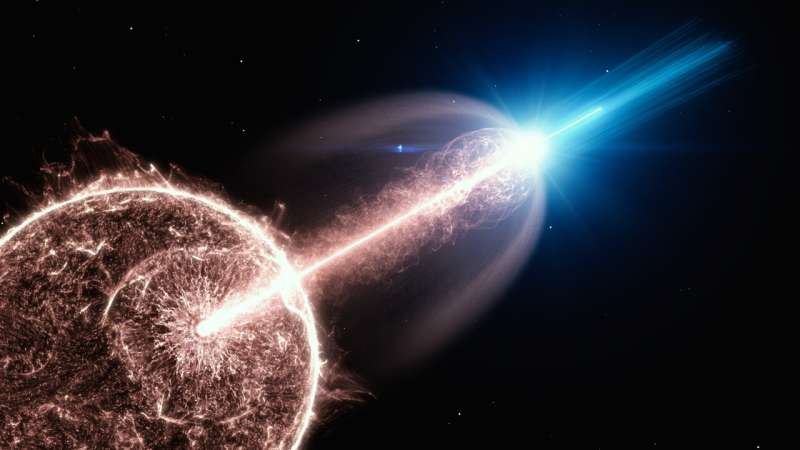Front-row view reveals exceptional cosmic explosion

Scientists have gained the best view yet of the brightest explosions in the universe: A specialized observatory in Namibia has recorded the most energetic radiation and longest gamma-ray afterglow of a so-called gamma-ray burst (GRB) to date. The observations with the High Energy Stereoscopic System (H.E.S.S.) challenge the established idea of how gamma-rays are produced in these colossal stellar explosions which are the birth cries of black holes, as the international team reports in the journal Science.
“Gamma-ray bursts are bright X-ray and gamma-ray flashes observed in the sky, emitted by distant extragalactic sources,” explains DESY scientist Sylvia Zhu, one of the authors of the paper. “They are the biggest explosions in the universe and associated with the collapse of a rapidly rotating massive star to a black hole. A fraction of the liberated gravitational energy feeds the production of an ultrarelativistic blast wave. Their emission is divided into two distinct phases: an initial chaotic prompt phase lasting tens of seconds, followed by a long-lasting, smoothly fading afterglow phase.”
On 29 August 2019 the satellites Fermi and Swift detected a gamma-ray burst in the constellation of Eridanus. The event, cataloged as GRB 190829A according to its date of occurrence, turned out to be one of the nearest gamma-ray bursts observed so far, with a distance of about one billion lightyears. For comparison: The typical gamma-ray burst is about 20 billion lightyears away. “We were really sitting in the front row when this gamma-ray burst happened,” explains co-author Andrew Taylor from DESY. The team caught the explosion’s afterglow immediately when it became visible to the H.E.S.S. telescopes. “We could observe the afterglow for several days and to unprecedented gamma-ray energies,” reports Taylor.
Artist’s impression of very-high-energy photons from a gamma-ray burst entering Earths’ atmosphere and initiating air showers that are being recorded by the telescopes of the High Energy Stereoscopic System (H.E.S.S.) in Namibia. Credit: DESY, Science Communication Lab
The comparatively short distance to this gamma-ray burst allowed detailed measurements of the afterglow’s spectrum, which is the distribution of “colors,” or photon energies, of the radiation in the very-high energy range. “We could determine GRB 190829A’s spectrum up to an energy of 3.3 tera-electronvolts, that’s about a trillion times as energetic as the photons of visible light,” explains co-author Edna Ruiz-Velasco from the Max Planck Institute for Nuclear Physics in Heidelberg. “This is what’s so exceptional about this gamma-ray burst—it happened in our cosmic backyard where the very-high-energy photons were not absorbed in collisions with background light on their way to Earth, as it happens over larger distances in the cosmos.”
The team could follow the afterglow up to three days after the initial explosion. The result came as a surprise: “Our observations revealed curious similarities between the X-ray and very-high energy gamma-ray emission of the burst’s afterglow,” reports Zhu. Established theories assume that the two emission components must be produced by separate mechanisms: the X-ray component originates from ultra-fast electrons that are deflected in the strong magnetic fields of the burst’s surroundings. This “synchrotron” process is quite similar to how particle accelerators on Earth produce bright X-rays for scientific investigations.
However, according to existing theories it seemed very unlikely that even the most powerful explosions in the universe could accelerate electrons enough to directly produce the observed very-high-energy gamma rays. This is due to a “burn-off limit,” which is determined by the balance of acceleration and cooling of particles within an accelerator. Producing very-high energy gamma-rays requires electrons with energies well beyond the burn-off limit. Instead, current theories assume that in a gamma-ray burst, fast electrons collide with synchrotron photons and thereby boost them to gamma-ray energies in a process dubbed synchrotron self-Compton.
X-rays from the gamma-ray burst were detected by NASA’s Swift satellite in Earth’s orbit. Very-high-energy gamma rays entered the atmosphere and initiated air showers that were detected by the H.E.S.S. telescopes from the ground (artist’s impression). Credit: DESY, Science Communication Lab
But the observations of GRB 190829A’s afterglow now show that both components, X-ray and gamma ray, faded in sync. Also, the gamma-ray spectrum clearly matched an extrapolation of the X-ray spectrum. Together, these results are a strong indication that X-rays and very-high-energy gamma rays in this afterglow were produced by the same mechanism. “It is rather unexpected to observe such remarkably similar spectral and temporal characteristics in the X-ray and very-high energy gamma-ray energy bands, if the emission in these two energy ranges had different origins,” says co-author Dmitry Khangulyan from Rikkyo University in Tokyo. This poses a challenge for the synchrotron self-Compton origin of the very-high energy gamma-ray emission.
The far-reaching implication of this possibility highlights the need for further studies of very-high energy GRB afterglow emission. GRB 190829A is only the fourth gamma-ray burst detected from the ground. However, the earlier detected explosions occurred much farther away in the cosmos and their afterglow could only be observed for a few hours each and not to energies above 1 tera-electronvolts (TeV). “Looking to the future, the prospects for the detection of gamma-ray bursts by next-generation instruments like the Cherenkov Telescope Array that is currently being built in the Chilean Andes and on the Canary Island of La Palma look promising,” says H.E.S.S. spokesperson Stefan Wagner from Landessternwarte Heidelberg. “The general abundance of gamma-ray bursts leads us to expect that regular detections in the very-high energy band will become rather common, helping us to fully understand their physics.”



 Creators of mankind
Creators of mankind Description of “Tall white aliens”
Description of “Tall white aliens” Where they came from?
Where they came from? About hostile civilizations
About hostile civilizations The war for the Earth
The war for the Earth “Tall white aliens” about eternal life
“Tall white aliens” about eternal life Video: “Nordic aliens”
Video: “Nordic aliens” Aliens
Aliens Alien encounters
Alien encounters The aliens base
The aliens base UFO
UFO Technology UFO
Technology UFO Underground civilization
Underground civilization Ancient alien artifacts
Ancient alien artifacts Military and UFO
Military and UFO Mysteries and hypotheses
Mysteries and hypotheses Scientific facts
Scientific facts


















